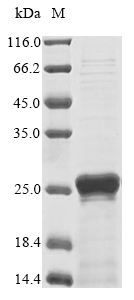This recombinant Gorilla gorilla gorilla Fibroblast Growth Factor comes from an in vitro E. coli expression system and contains the complete mature protein sequence spanning amino acids 29 to 209. The protein carries an N-terminal 10xHis-tag and shows greater than 85% purity when analyzed by SDS-PAGE. It's intended strictly for research purposes and works well in various experimental applications that demand high-quality reagents.
Fibroblast growth factors play essential roles in biological processes like cell growth, development, and tissue repair. These proteins participate in key signaling pathways that control how cells multiply and differentiate. This makes them particularly valuable for researchers working in developmental biology and regenerative medicine, where they may provide important clues about cellular responses and possible therapeutic uses.
Potential Applications
Note: The applications listed below are based on what we know about this protein's biological functions, published research, and experience from experts in the field. However, we haven't fully tested all of these applications ourselves yet. We'd recommend running some preliminary tests first to make sure they work for your specific research goals.
Gorilla FGF is a secreted signaling protein that requires precise folding, proper disulfide bond formation, and specific tertiary structure for its receptor binding and biological activity. The in vitro E. coli expression system (cell-free) provides a controlled environment but cannot ensure proper eukaryotic folding patterns or post-translational modifications. While cell-free systems can produce soluble proteins, the probability of correct disulfide bond formation and native-like folding for this growth factor requires experimental validation. The N-terminal 10xHis-tag may potentially interfere with the protein's receptor-binding domains or functional sites.
1. Comparative Evolutionary Studies of Fibroblast Growth Factor Function
This application requires functional validation to be meaningful. FGF-receptor interactions depend on precise tertiary structure and proper disulfide bonding. If correctly folded and active (verified through receptor binding assays), the protein enables valid evolutionary comparisons with human FGF. If misfolded/inactive (unverified), comparative binding studies will yield misleading evolutionary insights about species-specific functional differences.
2. Development of Species-Specific Detection Antibodies
This application is highly suitable as antibody development relies on sequence-specific epitope recognition rather than functional protein folding. The gorilla-specific FGF sequence provides unique epitopes for generating species-distinguishing antibodies, regardless of the protein's conformational state. The His-tag facilitates efficient purification and screening processes.
3. Protein-Protein Interaction Mapping Studies
This application carries a significant risk without proper folding validation. Functional FGF interactions with receptors and signaling partners require native conformation. If correctly folded (verified), the protein may identify genuine physiological interactions. If misfolded/unverified, there is a high risk of non-specific binding or failure to replicate authentic signaling complexes.
4. Structural and Biophysical Characterization Studies
These studies are essential priority applications for determining folding status. Techniques should include circular dichroism spectroscopy to assess secondary structure, size-exclusion chromatography to evaluate oligomeric state, and disulfide bond analysis to verify proper folding. However, the His-tag may interfere with crystallization for high-resolution structural studies.
5. In Vitro Biochemical Assay Development
This application is well-suited for developing detection methods targeting gorilla FGF. Immunoassays depend on epitope recognition rather than functional conformation. The protein serves as an excellent standard for quantitative assay development, though functional assays would require additional validation.
Final Recommendation & Action Plan
The in vitro E. coli expression system provides a controlled production environment for this primate growth factor, but the folding status and functional competence require experimental validation before meaningful biological applications. Begin with Application 4 (Structural and Biophysical Characterization) to assess folding quality through CD spectroscopy, SEC, and disulfide bond analysis. Validate functional activity through receptor binding assays before proceeding with Applications 1 and 3 (evolutionary studies and interaction mapping). Applications 2 and 5 (antibody development and assay development) can proceed immediately, as they don't require functional validation. Always include appropriate controls and consider using mammalian-expressed FGF for critical functional comparisons to ensure physiological relevance.






